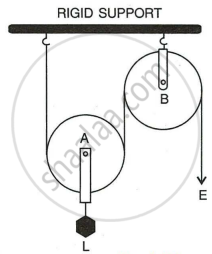Advertisements
Advertisements
Question
Give a reason for the following:
In a single fixed pulley, the velocity ratio is always more than the mechanical advantage.
Solution
In a single fixed pulley, some effort is wasted in overcoming friction between the strings and the grooves of the pulley; so the effort needed is greater than the load and hence the mechanical advantage is less than the velocity ratio.
APPEARS IN
RELATED QUESTIONS
Is the above pulley system an ideal machine or not?
Answer the following in short.
Explain the various functions that a machine can perform.
In a gear system, the gear ration of the driving wheel A and driven wheel B is 10:1. To rotate the driven wheel B in the direction of driving wheel A, the driving wheel A is engaged with other wheel C. what should be the gear ratio of the wheels A and C?
The diagram below shows a pulley arrangement.
- Name the pulleys A and B.
- In the diagram, mark the direction of tension on each strand of string.
- What is the purpose of the pulley B?
- If the tension is T, deduce the relation between
- T and E, and
- E and L.
- What is the velocity ratio of the arrangement?
- Assuming that the efficiency of the system is 100%, what is the mechanical advantage?

Differentiate between a single fixed pulley and a single movable pulley.
A block and tackle pulley system has a velocity ratio 5. Draw a labelled diagram of this system. In your diagram, indicate clearly the points of application and the directions of the load and effort.
Give reason for the following:
In case of a block and tackle arrangement, the mechanical advantage increases with the increase in the number of pulleys.
A pulley system has a velocity ratio 3. Draw a diagram showing the point of application and direction of load (L), effort (E) and tension (T). It lifts a load of 150 N by an effort of 60 N. Calculate its mechanical advantage. Is the pulley system ideal? Give reason.
Give reason for the following:
In case of a block and tackle system, the mechanical advantage increases with the increase in the number of pulleys.
Draw the diagram of a single movable pulley and obtain its mechanical advantage, velocity ratio, and efficiency.
